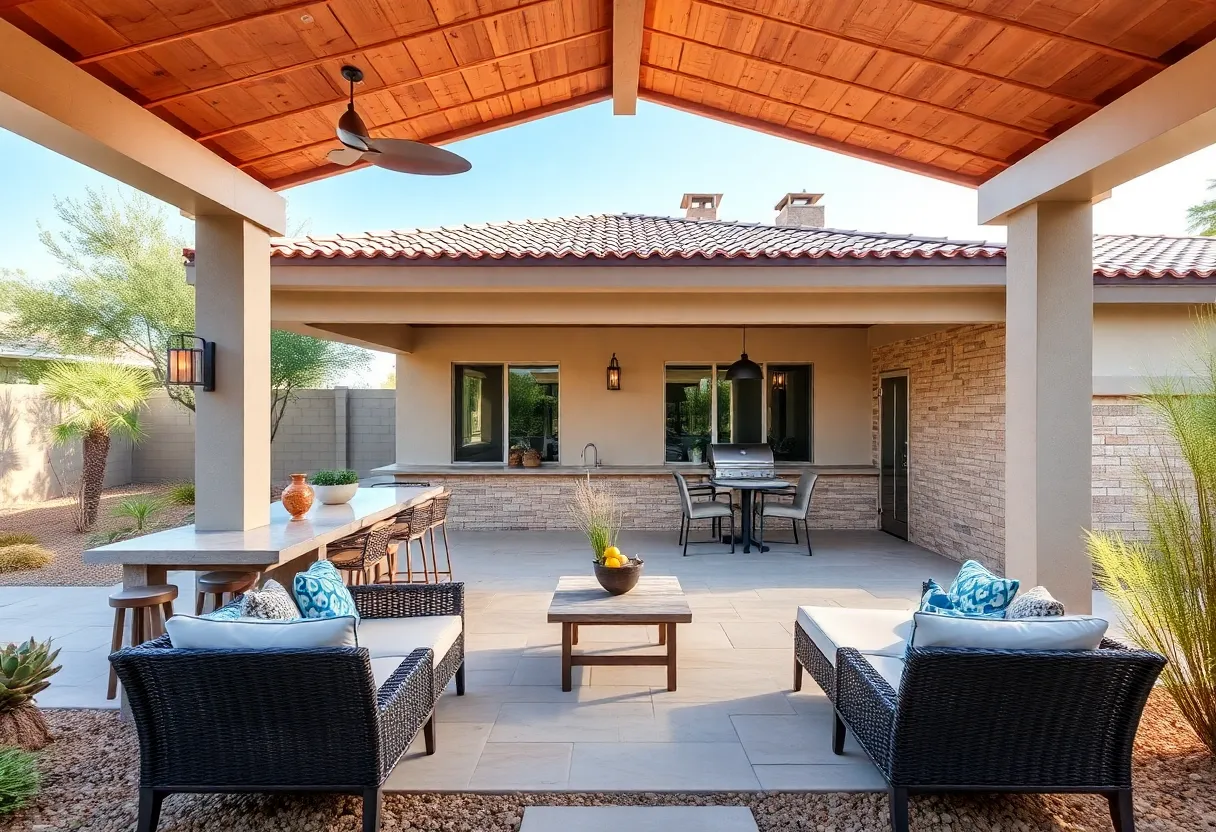Creating a Sustainable and Visually Appealing Landscape in Phoenix: The Essential Guide to Choosing Desert Plants
Designing a landscape in Phoenix that is both sustainable and visually striking requires careful selection of plant species adapted to the harsh desert environment. Prioritizing native and drought-tolerant plants ensures minimal water usage, reduced maintenance, and a natural alignment with local ecosystems. This article explores the vital considerations for choosing desert plants and highlights top species suited for the Sonoran landscape.
Core Considerations for Selecting Desert Plants in Phoenix
Climate Adaptation
Plants for Phoenix must endure extreme heat and limited rainfall. Native desert species have evolved to thrive under these conditions, making them reliable choices. These plants require less water, tolerate temperature fluctuations, and are generally more resistant to pests and diseases.
Water Efficiency
In arid climates, water conservation is critical. Selecting drought-tolerant species reduces dependency on supplemental irrigation. Such plants have adaptations like deep roots, thick leaves, or water-storing tissues that make them self-sufficient during dry spells.
Soil Compatibility
Phoenix’s soil is typically well-drained and often alkaline. Ideal plants are those that naturally grow in similar soil conditions. Avoiding plants that prefer rich, moist soils ensures better growth and reduces the need for soil amendments.
Maintenance Requirements
A sustainable landscape demands low-maintenance plants. Native species generally require minimal pruning, fertilization, or pest control, making them suitable for busy homeowners or developers aiming for eco-friendly landscapes.
Top Desert Plants for Phoenix Landscapes
1. Saguaro (Carnegiea gigantea)
The saguaro is an iconic symbol of the Sonoran Desert, recognized globally for its impressive stature and distinctive arms. It prefers full sun and well-drained, rocky soils. Saguaros are remarkably durable, requiring minimal watering once established, and can live beyond 200 years, adding lasting value and character.
2. Palo Verde (Parkinsonia spp.)
As Arizona’s state tree, the palo verde stands out for its green bark that photosynthesizes and its Springtime displays of bright yellow flowers. It serves as natural shade, provides habitat for local fauna, and adapts well to urban environments due to its resilience.
3. Agave (Agave spp.)
Agaves are appreciated for their bold architectural form and water-storing thick leaves. They flourish in full sun and poor soils, requiring very little maintenance. Their unique forms add a sculptural aspect to the landscape.
4. Red Yucca (Hesperaloe parviflora)
Red yucca features slender, arching leaves and tall flower spikes with coral-red blossoms that draw hummingbirds. It thrives in full sun, demands minimal watering, and resists pests and diseases, making it ideal for xeriscapes.
5. Brittlebush (Encelia farinosa)
This hardy perennial exhibits silver-gray foliage and bright yellow, daisy-like flowers. It performs well under hot, dry conditions, attracts pollinators, and needs little supplemental water, making it a staple of native gardens.
6. Desert Marigold (Baileya multiradiata)
Desert marigold provides vibrant yellow blossoms during spring and summer. It thrives in full sun and well-drained soils, often used to add color and brightness to cactus gardens and native plant landscapes.
7. Texas Sage (Leucophyllum frutescens)
Recognized for its silvery foliage and purple flowers, Texas sage blooms profusely after rain. Its adaptability to arid conditions and ability to support pollinators make it a favored shrub for low-water xeriscaping.
8. Desert Spoon (Dasylirion wheeleri)
This architectural succulent introduces spiky, textured foliage, making it perfect for focal points. It tolerates extreme heat and is drought-hardy, requiring minimal upkeep, suitable for adding visual interest.
9. Ironwood Tree (Olneya tesota)
The ironwood offers dense canopy cover, lavender summer flowers, and provides essential shade that benefits both people and wildlife. Its deep-rooting system allows it to access water deep underground, adapting well to Phoenix’s environment.
10. Hedgehog Cactus (Echinocereus engelmannii)
This charming cactus features bright pink or magenta flowers, adding a splash of color and whimsy to rock gardens and borders. It’s low maintenance and tolerant of full sun, thriving with sparse watering.
Strategies for Designing a Desert-Friendly Landscape
Layering Techniques
Combine tall trees, such as ironwood or palo verde, with medium shrubs like desert sage, and ground covers like brittlebush. Layering adds depth, providing shade, visual interest, and habitat complexity.
Color Palette Considerations
Utilize a mix of greens, silvers, and vibrant flowering plants to create contrast. Colors like the yellow of brittlebush, purple of Texas sage, and red of red yucca enhance aesthetic appeal while maintaining desert harmony.
Incorporation of Texture
Mix plants with different leaf shapes—smooth, spiky, or feathery—to add tactile diversity, making the landscape more engaging and visually dynamic.
Supporting Local Wildlife
Select plants that attract pollinators like bees, hummingbirds, and butterflies, and provide shelter or food sources for native birds and insects, promoting an eco-friendly approach.
Maintenance Best Practices for Desert Landscapes
Watering
Most desert plants require watering only during establishment. Afterward, overwatering can induce root rot or pests. Employ deep, infrequent watering to encourage deep root growth.
Pruning and Care
Prune dying or damaged stems to promote healthy growth. Remove dead foliage and ensure plants retain their natural shapes with minimal intervention.
Mulching
Applying organic mulch conserves soil moisture, suppresses weeds, and maintains soil temperature. Use bark chips, gravel, or decomposed granite suited to desert landscapes.
Soil Management
Ensure proper drainage to prevent waterlogging. Native plants are adapted to alkaline, rocky, or sandy soils; avoid excessive soil amendment unless necessary.
Conclusion
Creating a sustainable, visually compelling landscape in Phoenix hinges on the deliberate selection of native and drought-tolerant plants. Incorporating species like saguaros, palo verdes, agaves, and desert marigolds ensures resilience to the desert’s climate while reducing water consumption and maintenance. Thoughtful landscape design that emphasizes layering, color, and texture along with low-impact maintenance strategies can result in an outdoor space that is both environmentally friendly and aesthetically pleasing, embodying the unique beauty of the Sonoran Desert.
Frequently Asked Questions
What are the best native plants for a desert landscape in Phoenix?
Ideal native plants include the saguaro, palo verde, brittlebush, desert marigold, ironwood, and hedgehog cactus. These species are naturally adapted to the climate and soil, requiring minimal water and maintenance.
How can I reduce water usage in my desert landscape?
Choose drought-tolerant native plants, employ efficient irrigation techniques like drip systems, and apply mulch to retain soil moisture. Regularly monitor and avoid overwatering to promote plant health.
What soil conditions are best for desert plants in Phoenix?
Most desert plants thrive in well-drained, often alkaline, or sandy soils. Avoid heavy, clay soils unless amended, as poor drainage can cause root problems.
How much maintenance does a native desert landscape require?
Once established, native desert landscapes generally require minimal maintenance—occasional pruning, watering during dry spells, mulching, and weed control.
Can desert plants provide habitat for local wildlife?
Yes. Many desert plants support pollinators, such as bees and hummingbirds, and provide shelter and food for native birds and insects, fostering ecological balance.
Key Features of Top Deserts Plants for Phoenix
| Plant | Water Needs | Sunlight | Growth Habits | Visual Appeal |
|---|---|---|---|---|
| Saguaro | Low (after establishment) | Full sun | Tall, structural | Iconic, towering |
| Palo Verde | Low | Full sun | Medium, sprawling | Green bark, vibrant flowers |
| Agave | Very low | Full sun | Compact, rosette | Bold, architectural |
| Red Yucca | Low | Full sun | Clumping, upright | Colorful, attracting pollinators |
| Brittlebush | Minimal | Full sun | Ground cover, bushy | Bright yellow, cheerful |
Author: STAFF HERE PHOENIX WRITER
The PHOENIX STAFF WRITER represents the experienced team at HEREPhoenix.com, your go-to source for actionable local news and information in Phoenix, Maricopa County, and beyond. Specializing in "news you can use," we cover essential topics like product reviews for personal and business needs, local business directories, politics, real estate trends, neighborhood insights, and state news affecting the area—with deep expertise drawn from years of dedicated reporting and strong community input, including local press releases and business updates. We deliver top reporting on high-value events such as the Waste Management Phoenix Open, Cactus League Spring Training, and Arizona State Fair. Our coverage extends to key organizations like the Greater Phoenix Chamber of Commerce and Visit Phoenix, plus leading businesses in technology and healthcare that power the local economy such as Intel and Banner Health. As part of the broader HERE network, including HERETucson.com, we provide comprehensive, credible insights into Arizona's dynamic landscape.





